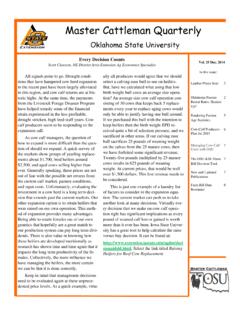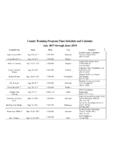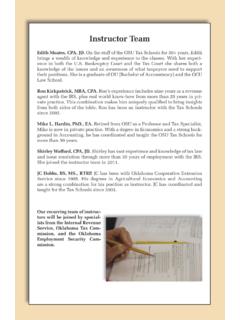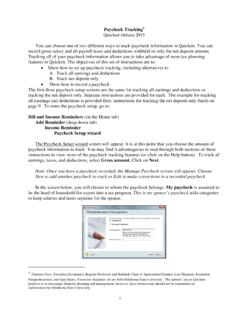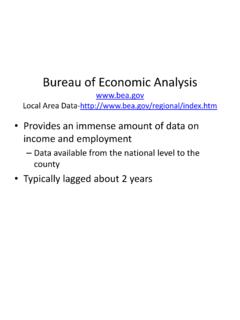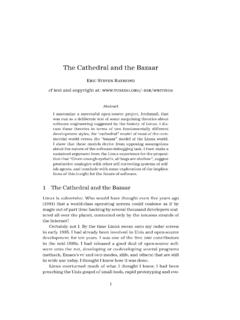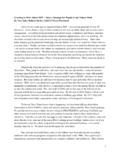Transcription of Master Cattleman Quarterly - agecon.okstate.edu
1 In this issue: Transfer of Passive Immunity from Dams to Baby Calves 1 Upcoming Events 1 Supplement or Replacer -What s the Difference? 2 Wheat Stocker Graze Out Decision Tool Available 2 IFMAPS: A Partner in Farm Financial Planning 3 Beef Calf Retention Deci-sion Tool 4 New Quicken Instructions 4 Producer Spotlight 5 Simple Changes: Cross-breeding builds profitable genetics 6 Oklahoma Quality Beef Network Update 8 Master Cattleman Quarterly Oklahoma State University Contributors in this issue: Glenn Selk Damona Doye Eric DeVuyst Kellie Raper David Lalman Clifford Mitchell Doug McKinney Resistance to disease is greatly de-pendent on antibodies or immunoglobulins and can be either active or passive in origin. Baby calves are born with an im-mune system. However, they have not yet produced antibodies ( active immunity) for disease protection. In active immu-nity, the body produces antibodies in re-sponse to infection or vaccina-tion.
2 Passive immunity gives temporary protection by transfer of certain immune substances from resistant individuals. An example of passive immunity is passing of antibodies from dam to calf via the co-lostrum (first milk after calving). This transfer only occurs during the first few hours following birth. Research (Wittum and Perino, 1995) conducted on over 200 calves, indicated that successful transfer of passive immunity, within hours of birth to a newborn calf, enhances disease resistance and performance for many months, even through the feedlot phase. Timing of colostrum feeding is important because the absorption of immu-noglobulins from colostrum decreases rap-idly from birth. "Intestinal closure" occurs because specialized absorptive cells are sloughed from the gut epithelium. The very large molecules (immunoglobulins) are no longer absorbed by the intestine and released into the circulation. In calves, closure is virtually complete 24 hours after birth.
3 Efficiency of absorption de-clines steadily from birth, particularly after 12 hours. Feeding may induce earlier clo-sure, but there is little colostral absorption after 24 hours of age, even if the calf is starved. This principle of timing of colos-trum feeding holds true whether the colos-trum is consumed directly from the first milk of the dam or supplied by hand. Producers should provide high risk baby calves (born to thin first calf heifers or calves that endured a difficult birth) at least 2 quarts of fresh or thawed frozen co-lostrum within the first 6 hours of life and another 2 quarts within another 12 hours. This is especially important for those baby calves too weak to nurse natu-rally. Thaw frozen colostrum very slowly in warm water so as to not allow it to over-heat. A microwave oven can be used only if it is set on low power and the frozen co-lostrum is very slowly thawed. A slow thaw means denaturation of the protein does not occur.
4 If at all possible, feed the calf natural colostrum first, before feeding commercial colostrum substitutes. Re-member, the first feeding of milk or colos-trum will induce faster intestinal closure. December 2009 Volume 5 Transfer of Passive Immunity from Dams to Baby Calves Glenn Selk, OSU Extension Animal Reproduction Specialist Southeastern Master Cattleman Mini-Summit Southeast Oklahoma Expo Center McAlester, OK March 24, 2010, 9 4 Oklahoma Beef Industry Conference Oklahoma State University Stillwater, OK April 8 - 9, 2010 Call Chris Richards at 405-744-6060 Upcoming Events Beef cow calf producers occasionally will need to provide commercial colostrum to baby calves that are born to two-year old heifers with very little milk, or to calves after a difficult birth. Some of these calves are very sluggish and slow to get up and find the teat. There-fore, they may not get the colostrum that they need to achieve successful passive transfer unless colostrum is provided by the cattle manager.
5 Knowing which prod-ucts to use in different situations can be very help-ful. Colostrum supplements are less expensive to pur-chase than colostrum replacers, but they may not be the best choice for the situation at hand. The following excerpt from a Pennsylvania State University publication that is published on the E-Extension website helps to sort out the differences: Colostrum products that contain Immunoglobu-lin G (IgG) are regulated by the USDA Center for Vet-erinary Biologics. Supplement products are unable to raise the blood concentration of IgG above the species standard, which is 10 mg/ml. Any product that is able to raise serum IgG concentration above 10 mg/ml may be called a colostrum replacer. Typically, colostrum supplements contain less than 100 g of IgG per dose and are composed of bovine colostrum, other milk products, or bovine serum. Colos-trum supplements can be used to increase the amount of IgG fed to calves when only low or medium quality co-lostrum is available.
6 However, supplements cannot re-place high quality colostrum. Even when a supplement is added to low quality colostrum, the IgG is often ab-sorbed poorly, and antibody absorption is reduced com-pared to high quality maternal colostrum. A limited number of products designed to re-place colostrum are now on the market. These are bo-vine serum-based products and contain at least 100 g of IgG per liter plus fat, protein, vitamins, and minerals needed by the newborn calf. Colostrum replacer con-tains more immunoglobulin than supplement products and provides more antibodies than poor or moderate quality colostrum. In research trials, calves fed colos-trum replacer have performed as well as calves fed ma-ternal colostrum with no differences in IgG levels, effi-ciency of IgG absorption, incidence of scours, or growth rates. Source: E-Extension website Colostrum Supplements and Replacer , Authors: Sylvia Kehoe, Coleen Jones, Jud Heinrichs, The Pennsylvania State University, Department of Dairy and Animal Science.
7 Supplement or Replacer - What's the Difference? Glenn Selk, OSU Extension Animal Reproduction Specialist Page 2 Master Cattleman Quarterly Wheat Stocker Graze Out Decision Tool Available Eric A. DeVuyst, OSU Extension Economist Although most producers have just placed stockers on wheat, it will soon be time to evaluate the end point for wheat grazing. Researchers have identi-fied first-hollow stem (FHS) as a critical decision point in wheat physiology. Grazing up to FHS usually has minimal effect on wheat grain yield. After FHS, graz-ing has been shown to significantly decrease wheat yields. In central Oklahoma, FHS typically occurs in the first week of March but varies annually due to weather conditions. While most wheat stocker produc-ers will pull stockers prior to or at FHS, are there cir-cumstances that justify grazing past FHS? The Graze Out Decision Aid was written to assist producers with determining the economically optimal grazing termina-tion date.
8 Using data supplied by the user, the program computes the expected economic outcomes of pulling stockers 14 days before FHS, seven days before FHS, at FHS, seven days post FHS, 14 days post FHS, or grazing out the wheat. Data requirements The program requires the user supply produc-tion information ( , average daily gains, death loss, and supplemental feeding cost), purchase price of stockers, and production costs including wheat lease terms. The program will download futures prices and basis for feeder cattle if the user clicks the download button and has access to the internet. Otherwise, the user can manually enter prices and basis. The program reports stocker revenues and costs in $/head and $/acre and breakeven sales price. The results also combine stocker and wheat revenues to Page 3 Master Cattleman Quarterly IFMAPS: A Partner in Farm Financial Planning Damona Doye, OSU Extension Economist Intensive Financial Management and Planning Support (IFMAPS), a special program of the Oklahoma Cooperative Extension Service, provides free and confi-dential financial planning assistance to Oklahoma farm and ranch families.
9 IFMAPS specialists work with fami-lies to gather information for financial plans. The plans typically include budgets for farm enterprises, a cash flow plan, income statement, balance sheet, debt work-sheet (if applicable), and financial measures. Specialists provide professional, timely, and friendly assistance in evaluating the business aspects of the farm or ranch. IFMAPS assistance is requested by Oklahoma producers considering a change in their operation, those simply wanting to get a better handle on their finances, and those applying for the Oklahoma Agricultural Linked Deposit Program. Producers with enterprises ranging from beef to tomato greenhouses have utilized the IF-MAPS program. IFMAPS staff have worked with pro-ducers in every county in the state since the program be-gan in 1985. There is no cost to Oklahoma producers for us-ing IFMAPS services. Funding for the specialists comes primarily from the state legislature through grants from the Oklahoma Department of Agriculture, with supple-ments from United States Department of Agriculture grants when available.
10 This program only requires your time. Spending several hours assembling your records and working with a specialist to review your financial situation can produce great rewards. To receive additional information or to schedule an appoint-ment to receive assistance, call IFMAPS toll-free 1 800 522 3755 or e-mail Requests for farm financial planning assistance can also be initiated through the Area Extension Agricultural Eco-nomics Specialists or the Oklahoma Cooperative Exten-sion Service s Extension Educators - Agriculture. Addi-tional information on the IFMAPS program is also avail-able at . The typical process for using the IFMAPS pro-gram is this: Producer contacts the IFMAPS Center on the Okla-homa State University campus at 1-800-522-3755. The case is assigned to a local IFMAPS specialist working for Extension on a part-time basis. These specialists have farm or ranch experience along with training in agricultural economics, accounting, or business.

